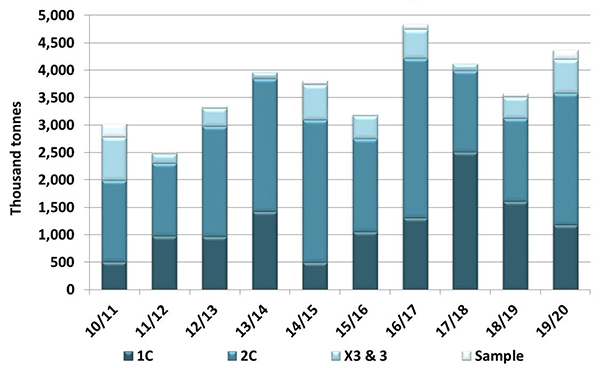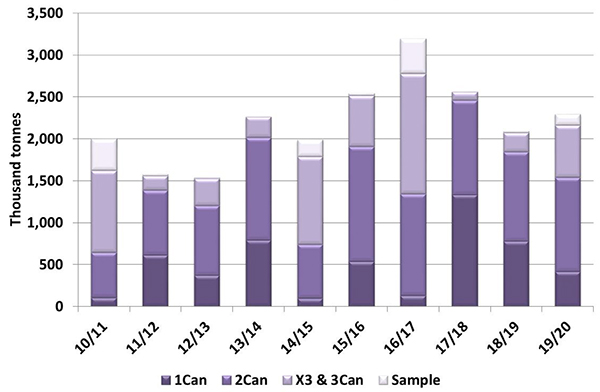December 19, 2019
Despite challenging harvest conditions, the grading breakdown is not that far from the average.

This year’s Canadian pulse harvest was significantly delayed in 2019. Crop development was slower than usual and adverse harvest weather caused crops to be left in the field longer than usual. This raised expectations that crop quality would be seriously reduced. While some damage was evident for pulses, it appears the quality ended up better than anticipated.
The main source of crop quality information comes from the Ag Ministries in Saskatchewan and Alberta, the two main pulse growing provinces. The grade breakdowns in the late season crop reports provide a reasonable picture of the crop quality.
For peas, these reports tell us that 25-30% of the 2019 crop ended up as a 1Can, compared to the 10-year average of 35%. Another 55% of the crop is reported as a 2Can, which is roughly in line with the average while 14% is estimated as an X3 or 3Can and 4% as Sample grade. Of course, this doesn’t tell us how the grades turned out for the yellow and green portions of the pea crop but it’s safe to assume that green peas faced more challenges due to the more stringent quality specs.

From the perspective of export capabilities, this year’s outcome is hardly seen as a disaster. Generally, the 2019 quality is close to average and shouldn’t limit potential, at least for yellows. The more serious quality concerns for green peas have certainly limited available supplies and caused prices to spike.
When it comes to lentils, it appears there was more damage from the harvest delays. Of course, it depends on whether you compare this year’s performance to the previous two positive years or against the severely damaged crops of 2016 and 2014. According to Sask Ag, 18% of lentils in 2019 were a 1Can compared to the 10-year average of 27%, 49% were a 2Can, 27% as an X3 or 3Can and 6% ended up as Sample.

Just like for peas, the overall grade profile obscures the greater impact on green lentils, due to more stringent requirements for colour. This is a key reason why green lentil prices have shown a larger response this fall. In general, while the lower quality of the 2019 lentil crop adds some challenges to the flow of exports, the issues aren’t large enough to severely restrict export flows, especially for red lentils.
The quality of the 2019 chickpea crop was also reduced, with nearly a quarter of the crop grading as Sample. Even so, large supplies of good quality chickpeas were carried over from 2018/19, meaning that total 2019/20 supplies will be sufficient to meet export demand.
Disclaimer: The opinions or views expressed in this publication are those of the authors or quoted persons. They do not purport to reflect the opinions or views of the Global Pulse Confederation or its members.